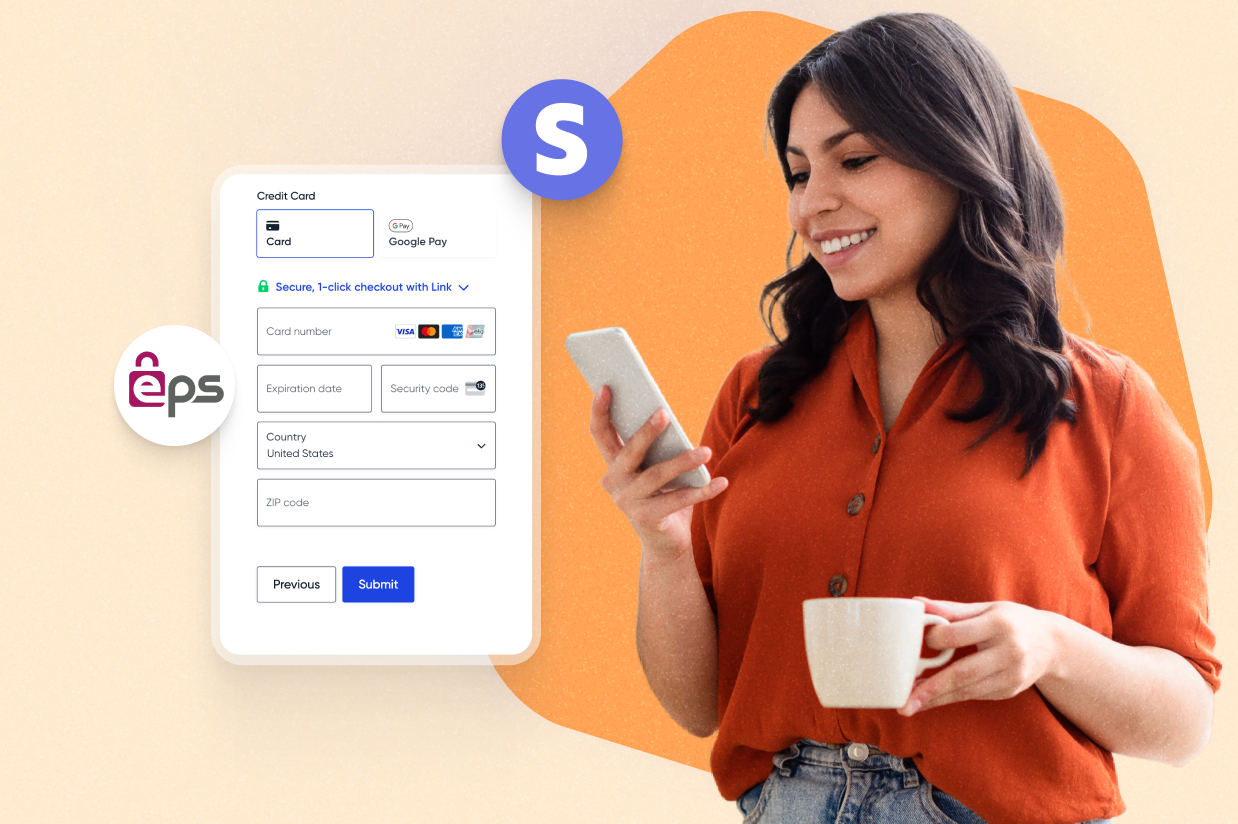How to Accept EPS Payments on WordPress with Stripe
Looking for a way to accept EPS payments on WordPress?
If you have customers in Austria, it can be important to offer EPS as a payment method.
With the Gravity Forms plugin and Stripe, you can easily set up a customizable WordPress EPS payment form – no technical knowledge needed.
You could have EPS be the sole payment method for your form or you can give people the ability to choose other options, such as their credit/debit cards, wallets like Apple Pay, and more.
Here’s an example of what it might look like, but you can fully customize it according to your preferences:
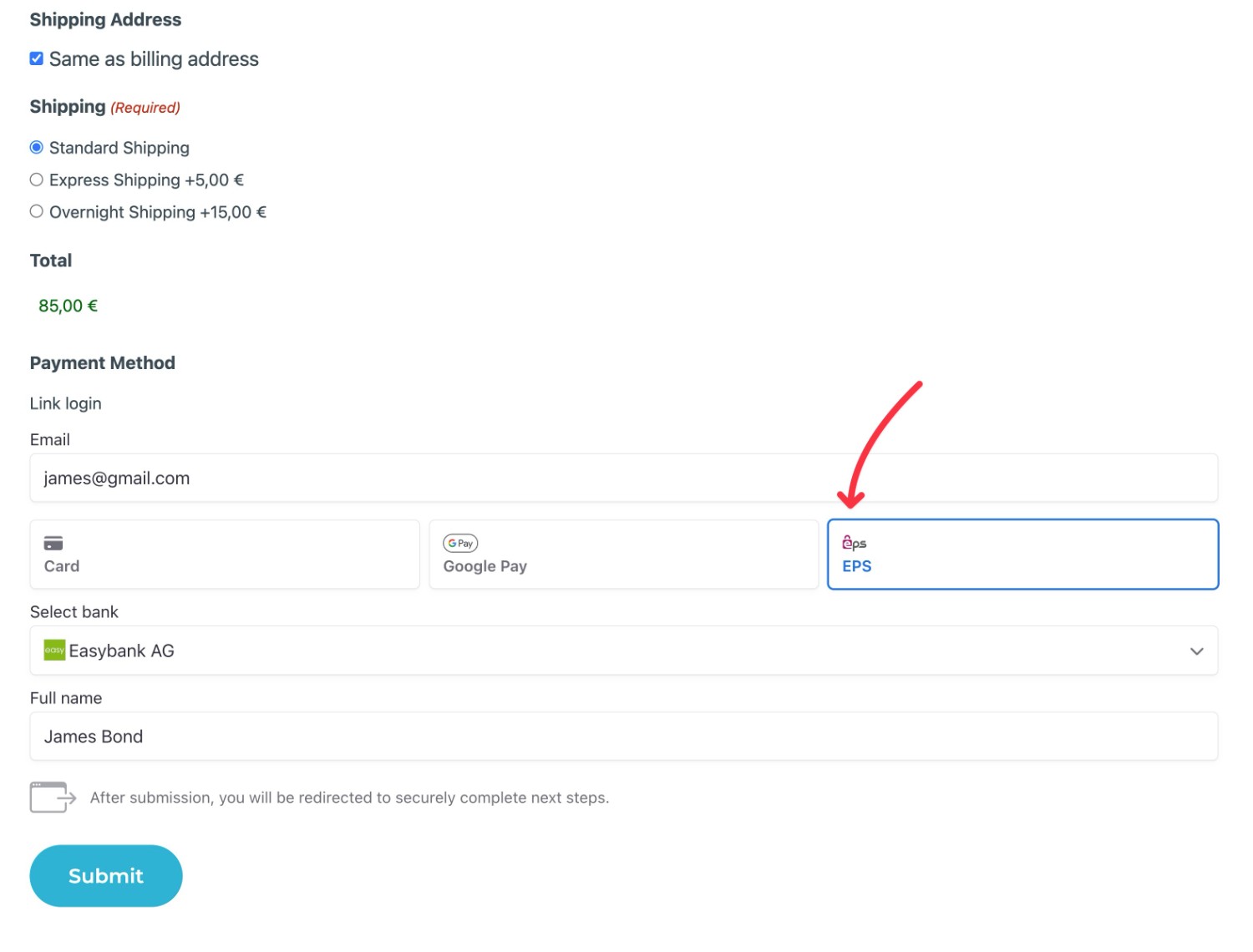
In this post, we’ll start with a quick introduction to EPS as a payment method and then we’ll cover a full, step-by-step tutorial for setting up your first WordPress EPS payment form.
Why Use EPS for WordPress Payments?
Short for Electronic Payment Standard, EPS is a popular payment method in Austria that lets people use their bank credentials to make online payments.
All Austrian banks support EPS and it’s accepted by over 80% of Austrian online retailers, so it’s an important payment method to offer if you have a lot of customers in Austria.
EPS can be convenient for customers because it lets them make payments without needing a credit or debit card. After choosing EPS as their payment method, they’ll be briefly redirected to their bank’s website to simply log in and authenticate the payment.
Because EPS payments require this authentication, they generally have a low risk of fraud, especially when compared with credit card payments. This lessens the risk of disputed payments, which can be another advantage of using EPS over other payment methods.
In terms of processing fees, Stripe charges 1.6% + €0.25 per transaction for EPS, which is about the same as standard credit card payments.
For reference, Stripe charges 1.5% + €0.25 per transaction for standard European Economic Area cards and 1.9% + €0.25 for premium cards (at the time of writing).
What You Need to Accept WordPress EPS Payments
If you want to accept EPS payments on WordPress, you’ll need the help of two tools:
- Stripe – With a free Stripe account, Stripe can seamlessly handle processing EPS payments, along with any other supported payment methods that you want to enable.
- Gravity Forms plugin – With the official Gravity Forms Stripe Add-On, you can create flexible payment forms that integrate with Stripe, including support for adding EPS as a payment option.
How to Create a WordPress EPS Payment Form
Now, let’s get into the actual step-by-step guide on how to create your own WordPress EPS payment form.
To follow this tutorial, we’ll only assume two things:
- You’ve already registered for your free Stripe account. If you haven’t done so yet, you can register for your account here.
- You’ve purchased at least the Gravity Forms Pro license (or the Elite or Nonprofit license), which is needed to access the official Stripe Add-On. If you haven’t done so yet, you can purchase your license here.
Let’s get into it…
1. Install Gravity Forms and the Stripe Add-On
To get started, install and activate the core Gravity Forms plugin on your WordPress site.
When completing the short setup wizard, make sure to choose Euro as your site’s default currency. EPS payments only work with Euros, so you won’t be able to use EPS with a different currency. You can always change this later on by going to Forms → Settings.
Once you’ve activated Gravity Forms and added your license key, you also need to install the Stripe Add-On:
- Go to Forms → Add-Ons.
- Find the Stripe Add-On in the list.
- Click Install to install it on your site.
- Once the installation finishes, make sure to also activate the add-on.
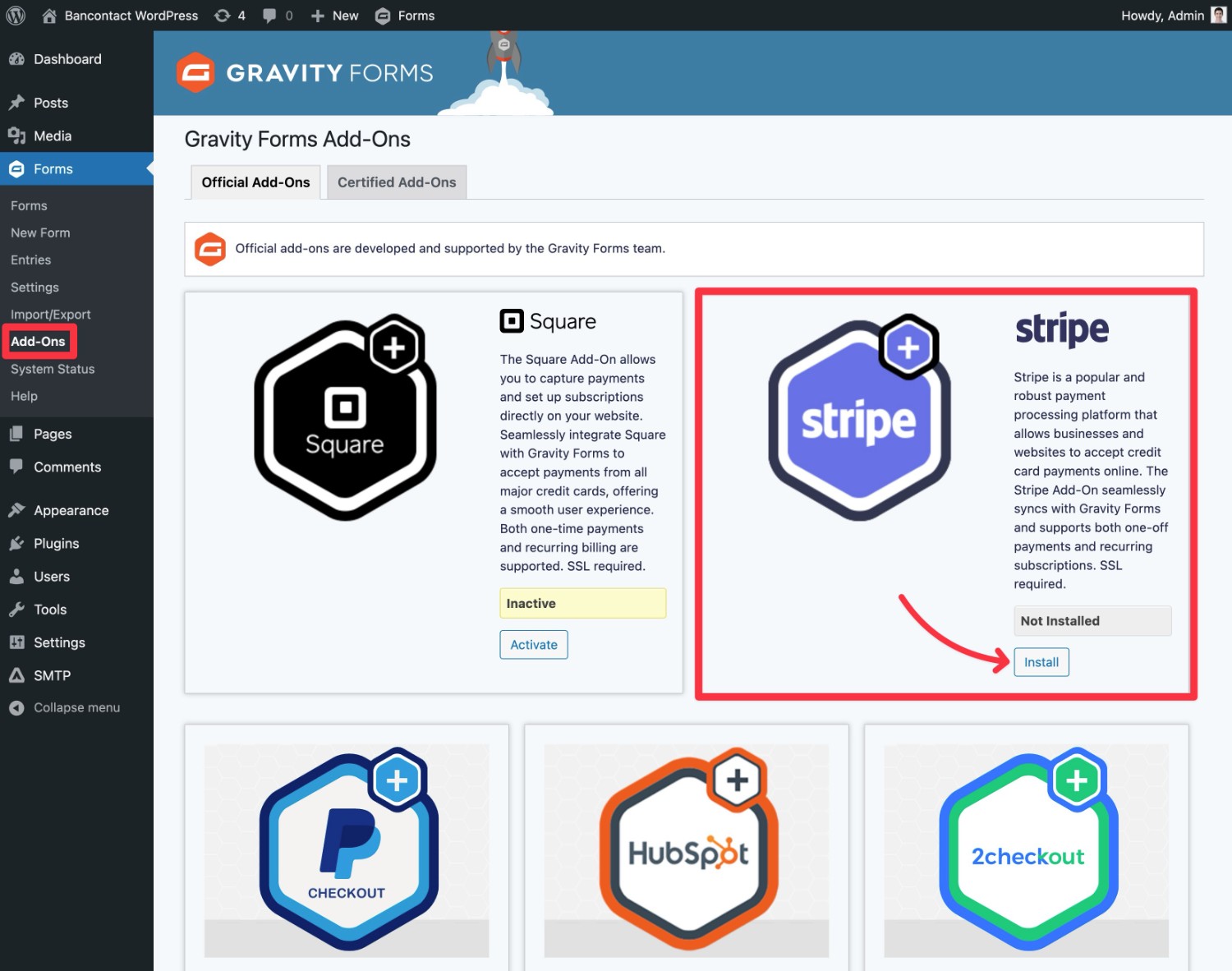
2. Connect Gravity Forms and WordPress to Stripe
Now, you need to connect WordPress and Gravity Forms to your Stripe account.
This involves completing a short authorization flow, adding the Gravity Forms webhook URL to your Stripe dashboard, and then adding the Stripe secret key to the Gravity Forms settings area.
You can read the full documentation on using the Stripe Add-On and connecting your site to Stripe, but we’ll take you through a quick version of each step below…
Connect to Stripe
To begin, open the Stripe Add-On settings area:
- Go to Forms → Settings in your WordPress dashboard.
- Select the Stripe tab in the sidebar.
For now, we recommend connecting to Stripe using Test mode. This allows you to test your form with dummy payments. When you’re ready to accept real payments, all you need to do is enable Live mode. We’ll cover this later in the tutorial.
To set up Test mode, select the Test radio button and then click Connect With Stripe.
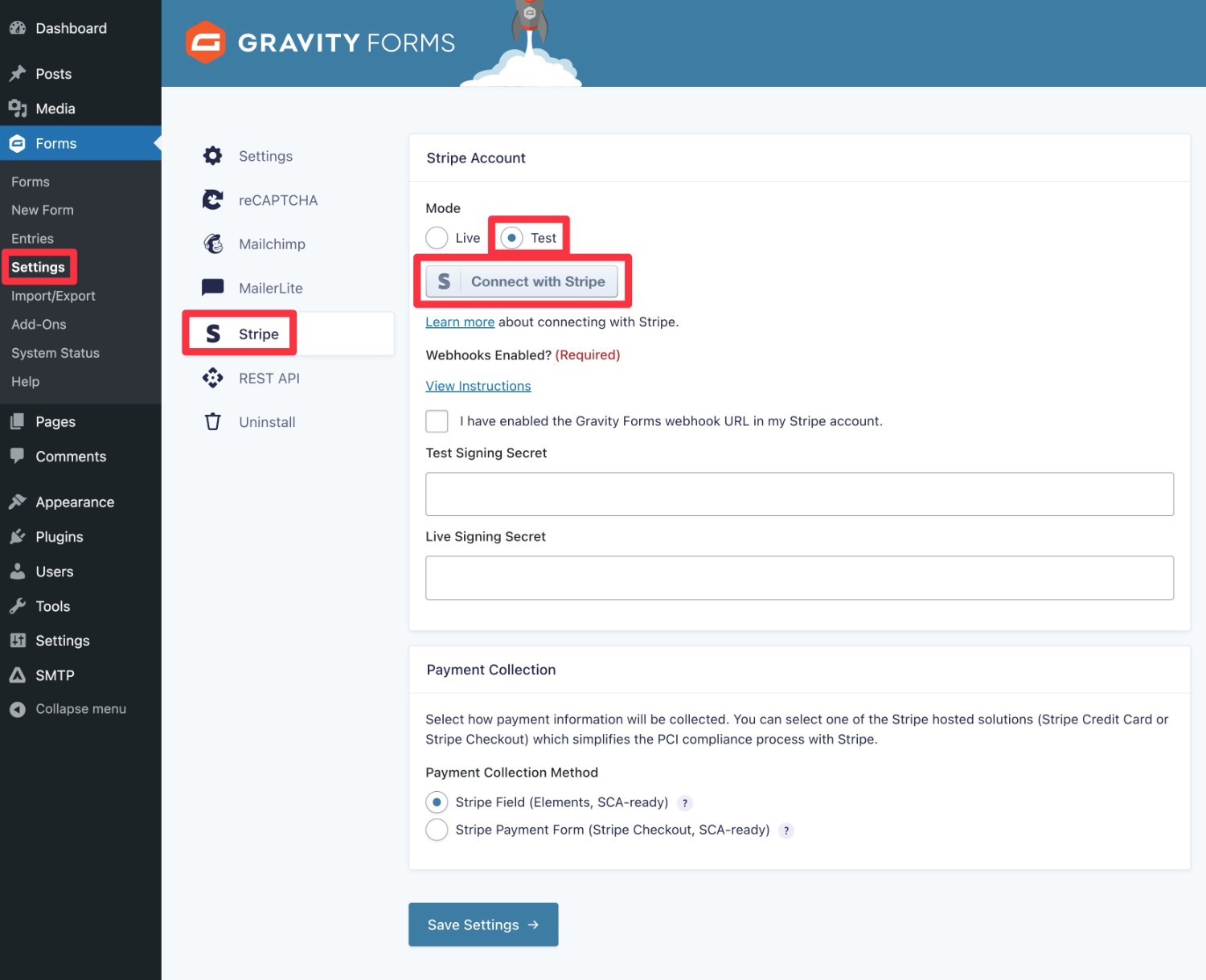
This will launch a short authorization flow. Choose the Stripe account that you want to use and click Connect.
You should then be redirected back to your WordPress dashboard.
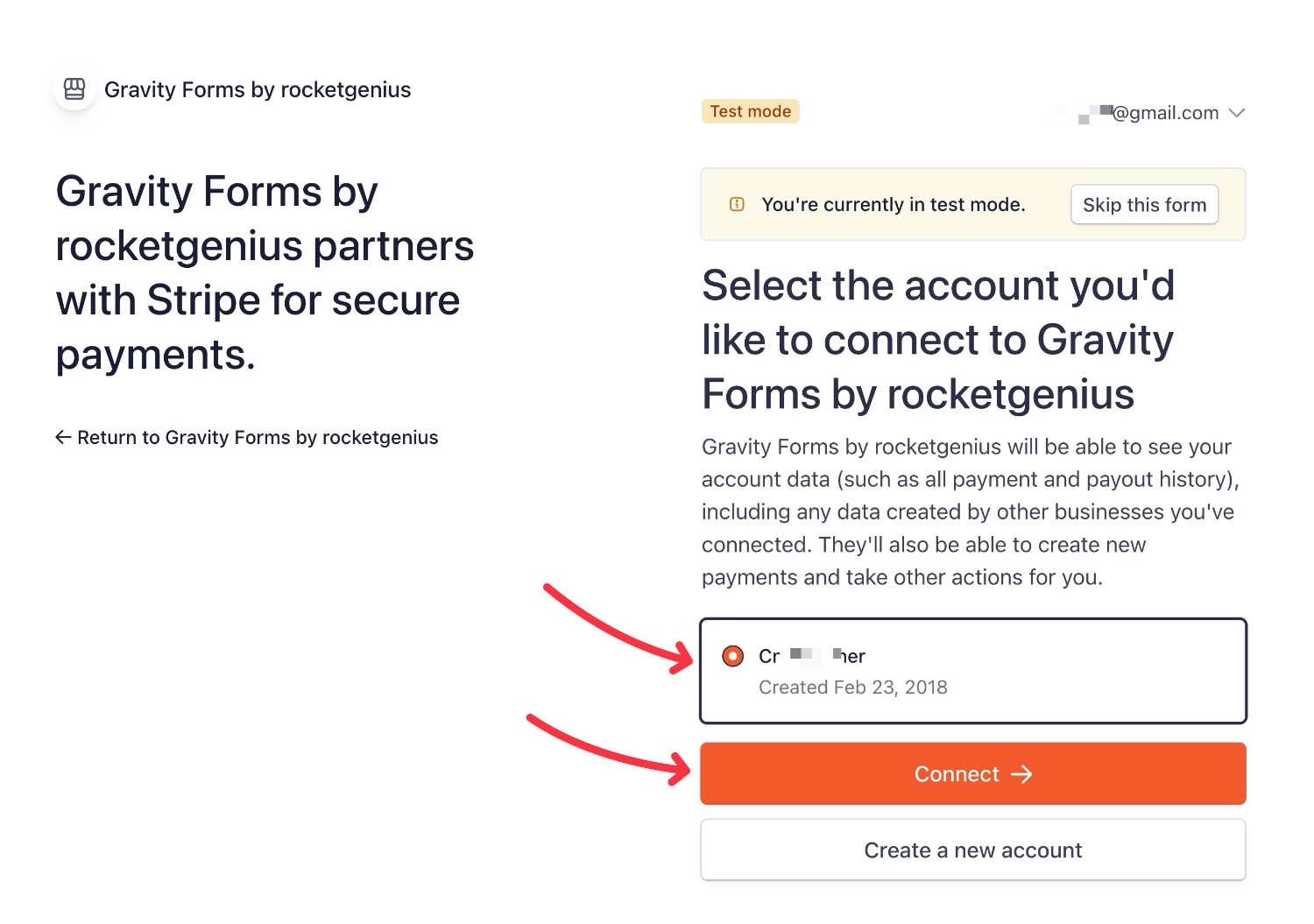
Add Webhooks and Signing Secret
Next, you need to add the Gravity Forms webhook URL to your Stripe account.
In your Stripe account, make sure that you’re using Test Mode. You can verify this using the toggle at the top of the Stripe interface and the links that we share below will take you straight to the test dashboard.
To open the full instructions and locate the URL, click the View Instructions link:
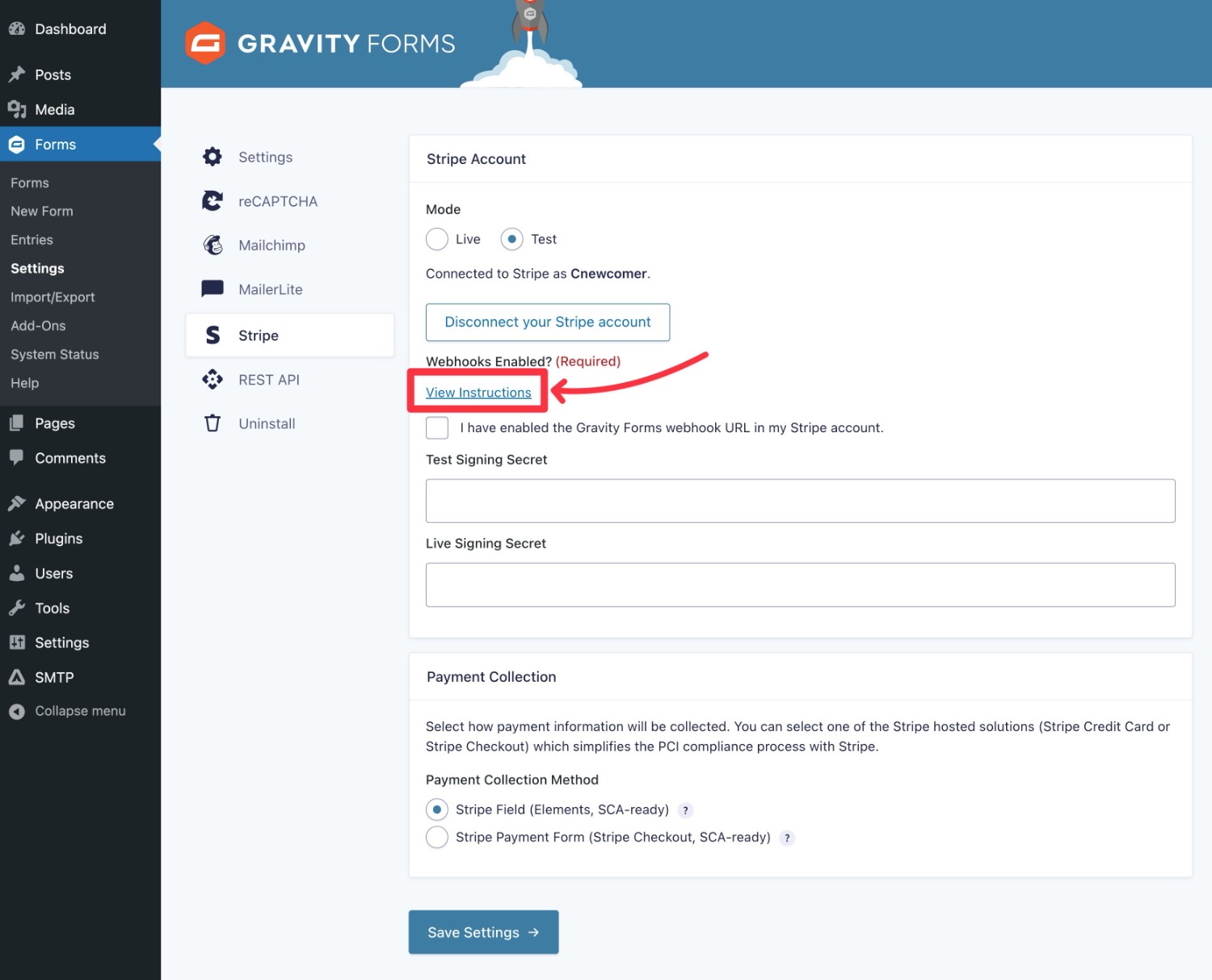
This will open a popup that includes the URL and instructions:
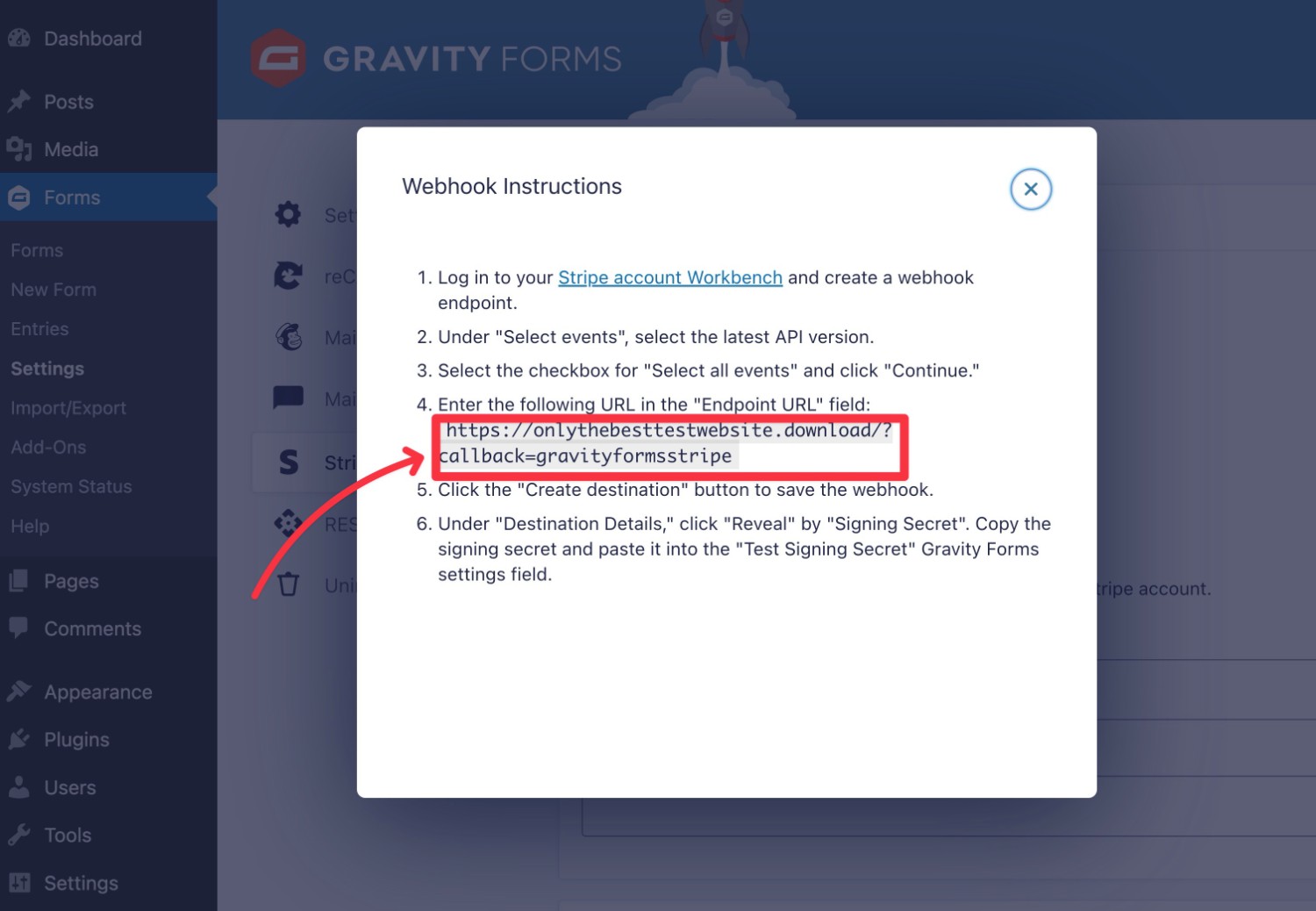
With this information, create a test endpoint URL in Stripe Workbench by clicking this link.
If you get redirected back to the main Stripe dashboard instead of seeing the Workbench interface, you’ll first need to enable Stripe Workbench in the Stripe Developers settings. Stripe has enabled Workbench as the default experience for new Stripe accounts, but existing Stripe account holders will not see Workbench unless they turn it on.
Here’s how to configure the webhook/event destination in Workbench:
- Events from – Your account.
- API version – Latest version.
- Events – check the Select all events checkbox.
Then, click Continue.
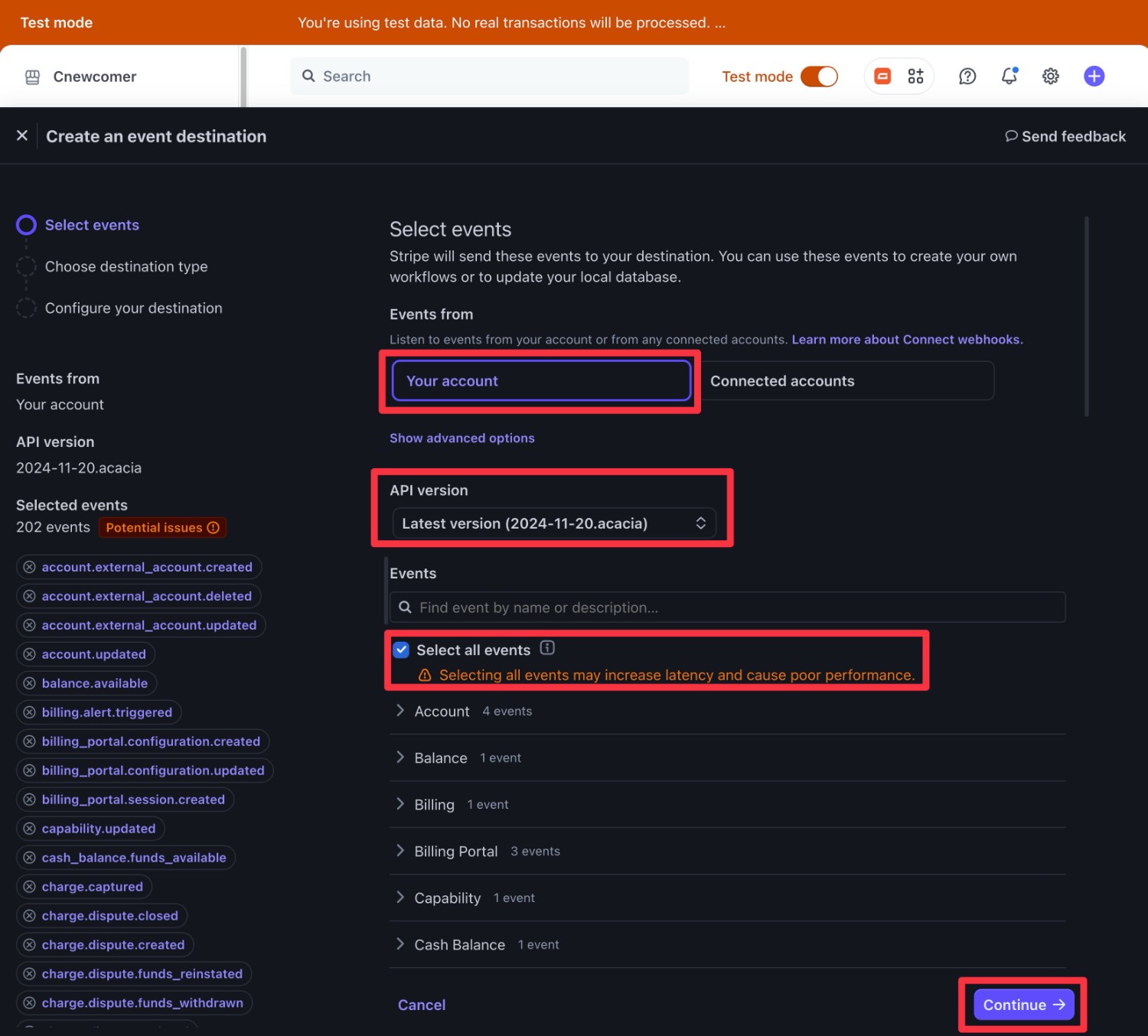
On the next screen, select Webhook endpoint and click Continue.
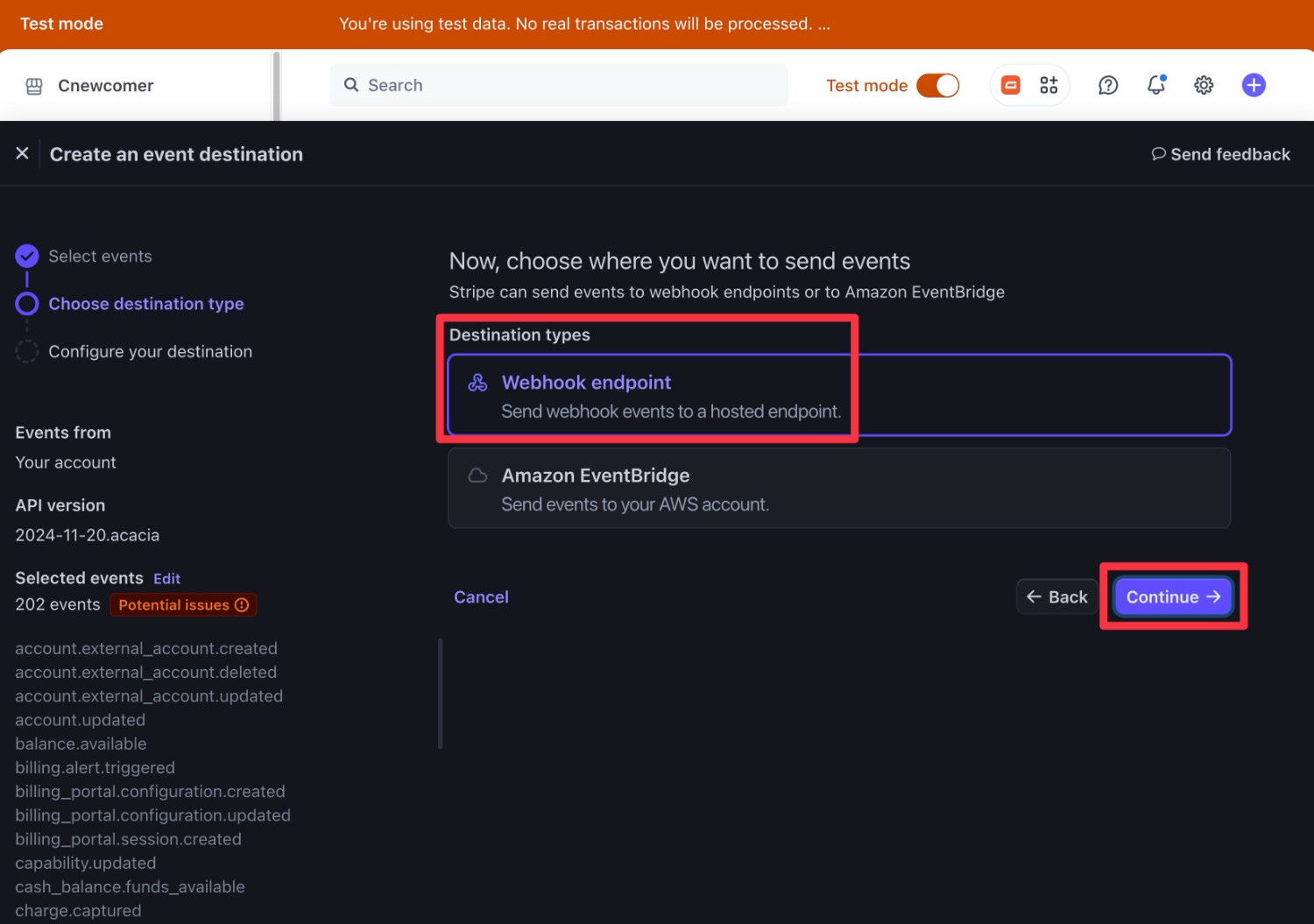
To finish the process, paste the Gravity Forms webhook URL into the box and then click Create destination.
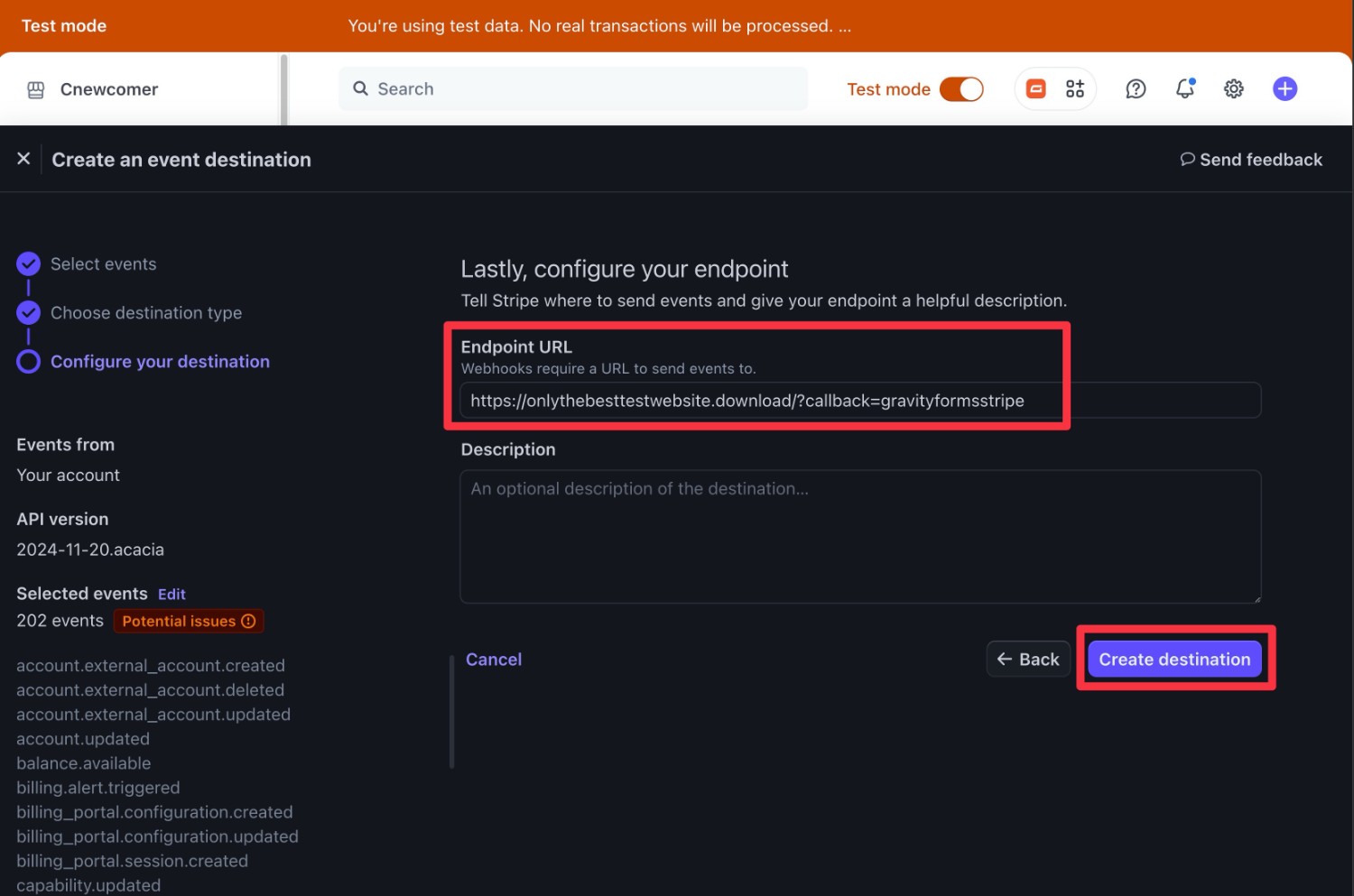
On the next screen, you need to find the Signing secret key. It should be listed in the Destination details column and it will start with whsec.
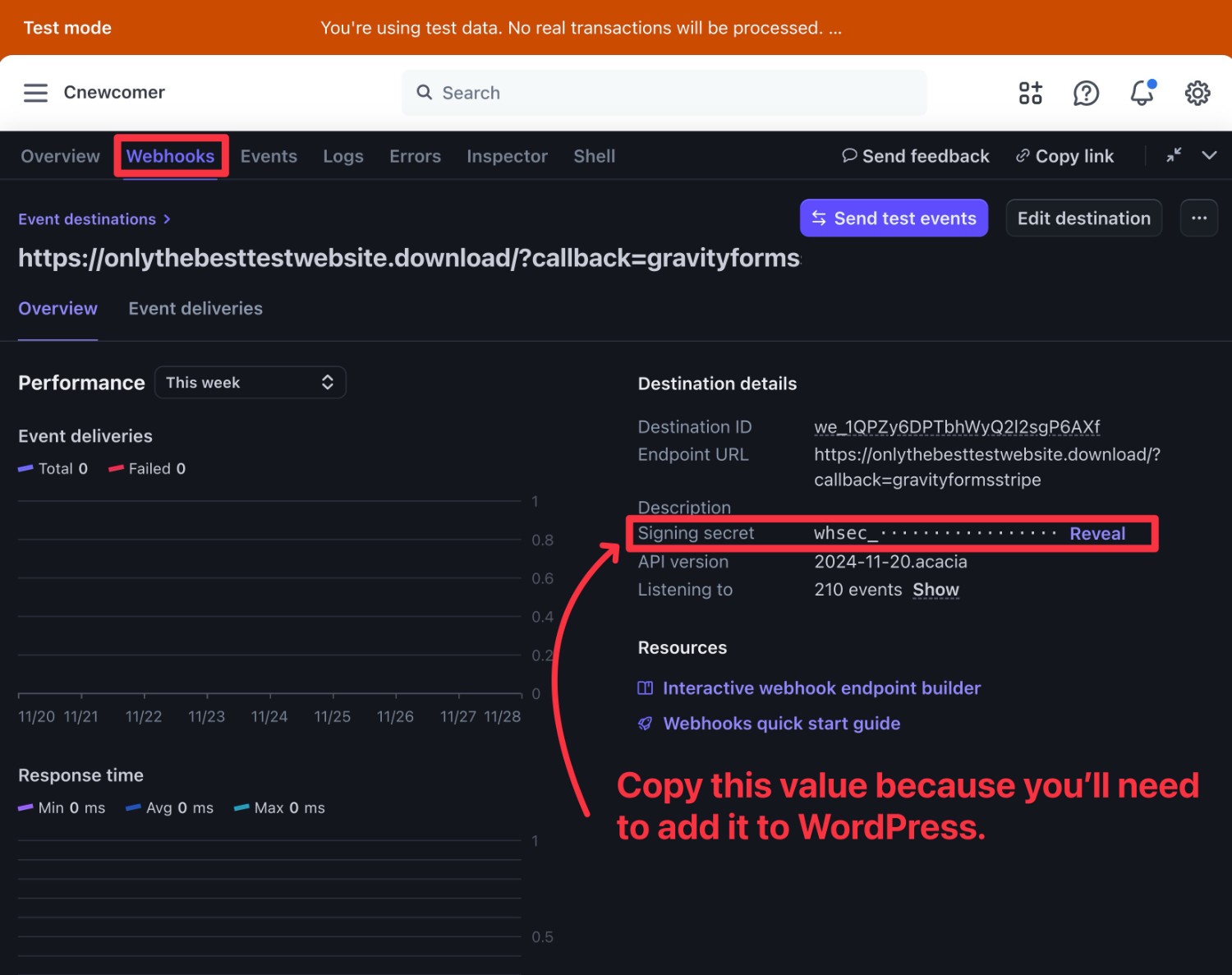
Once you’ve copied the test signing secret value, follow these steps:
- Go back to your WordPress dashboard.
- Paste the key into the Test Signing Secret box.
- Check the box verifying that you’ve enabled the webhook URL.
- Click Save Settings at the bottom.
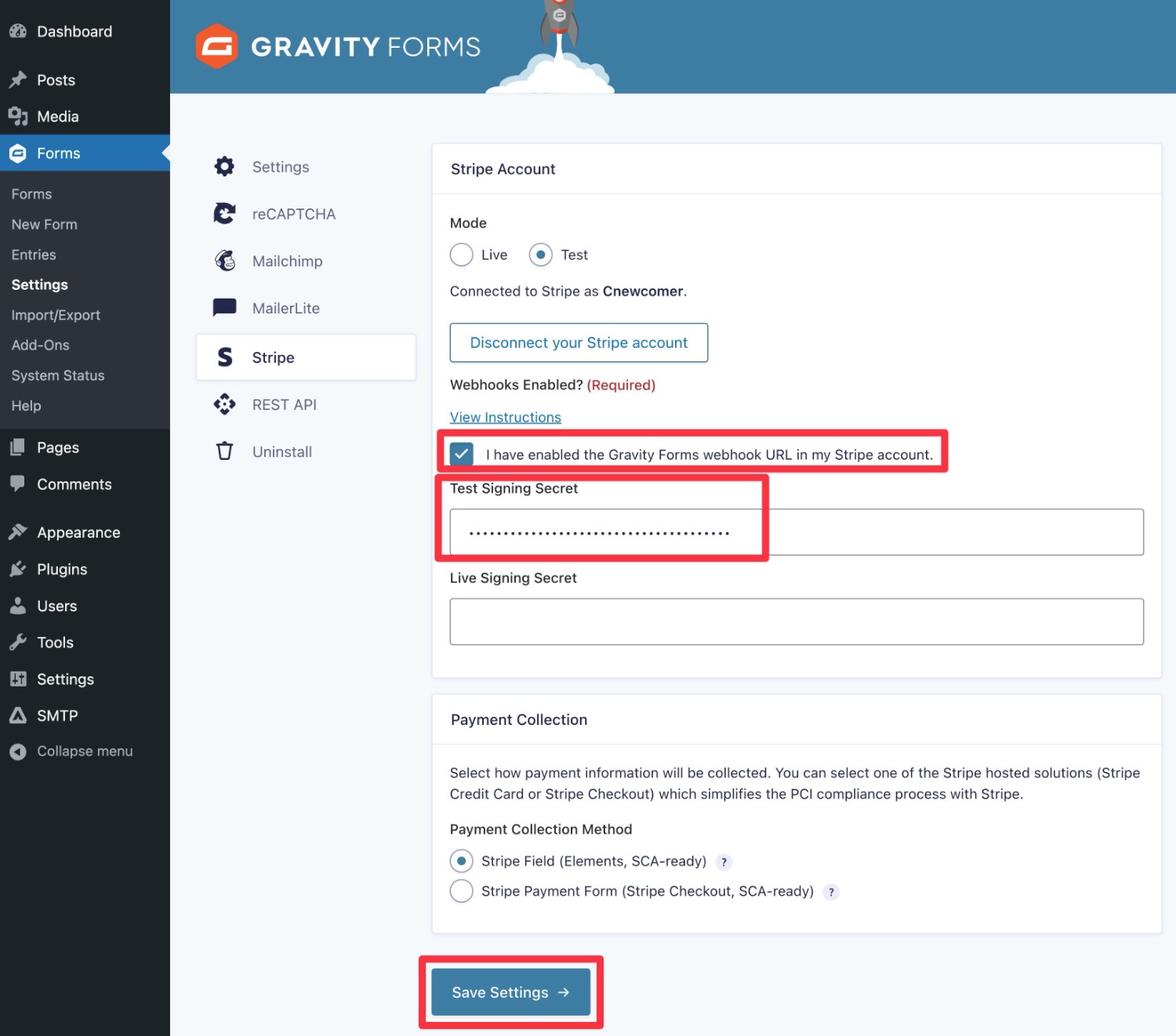
When you’re ready to accept real payments, you’ll essentially need to repeat these same steps for Live mode. However, we’ll cover that later in this post.
3. Enable EPS Payments in Stripe
If you want to use EPS payments in Stripe, you need to specifically activate EPS as a payment method in your Stripe account.
You need to activate EPS for both Live and Test modes in your Stripe dashboard. That is, you will need to activate it two times in both interfaces. You can switch between Live and Test modes by using the toggle at the top of the Stripe interface.
Here’s how to enable EPS:
- Open the payment methods settings area in Stripe – you can click this link for live mode and this link for test mode.
- Click on the Default drop-down and choose the Default option underneath “Gravity Forms by Rocketgenius” configuration.
- Find the EPS option – it should be at the bottom under Bank redirects.
- Click Turn on. If a popup appears, click Continue.
- Look for the green checkmark and Active text, which confirms that EPS will be active for your payment forms.
Here’s how to choose the “Gravity Forms by Rocketgenius” configuration:
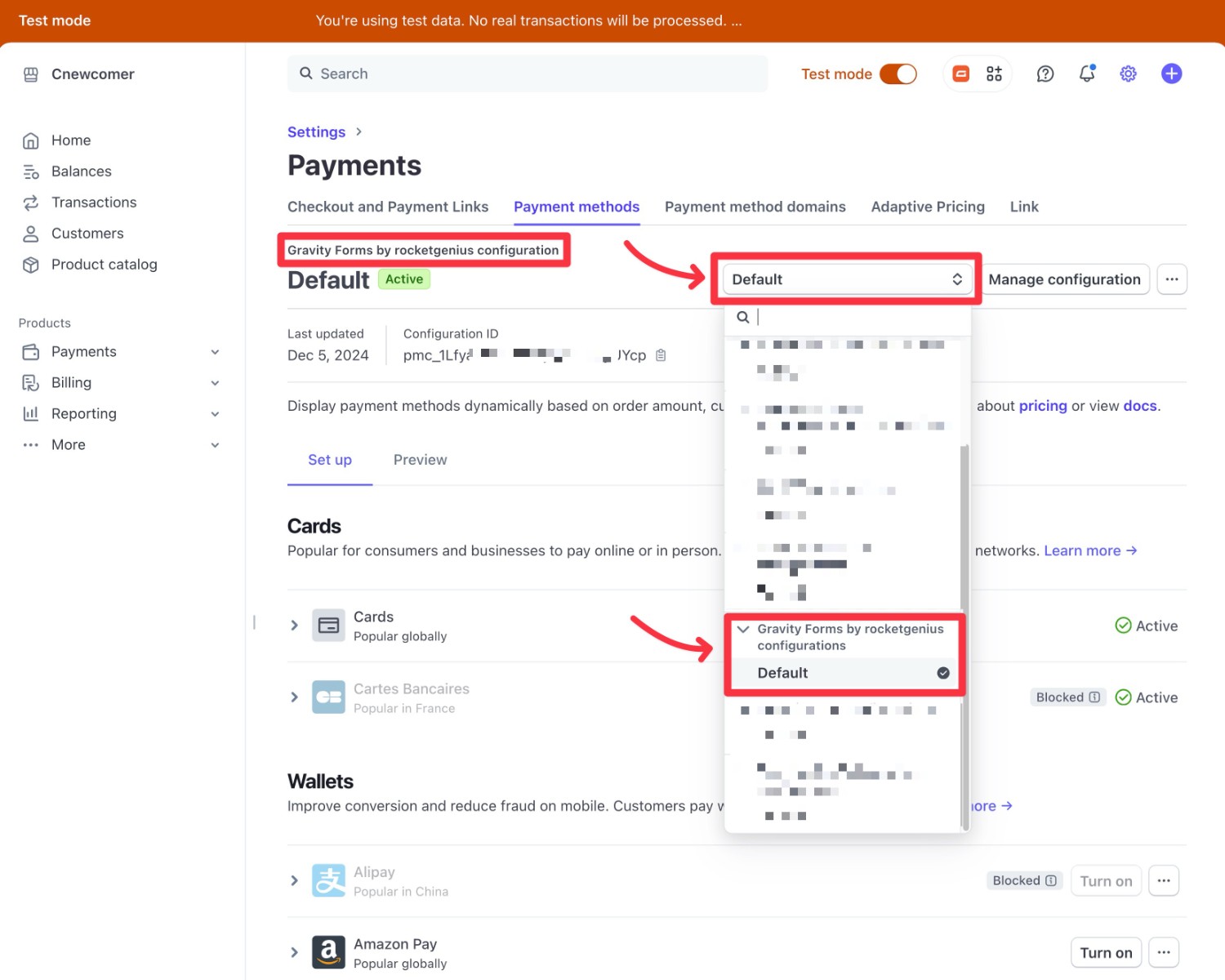
Here’s how to turn on EPS – again, you must turn on EPS for both Live and Test modes:
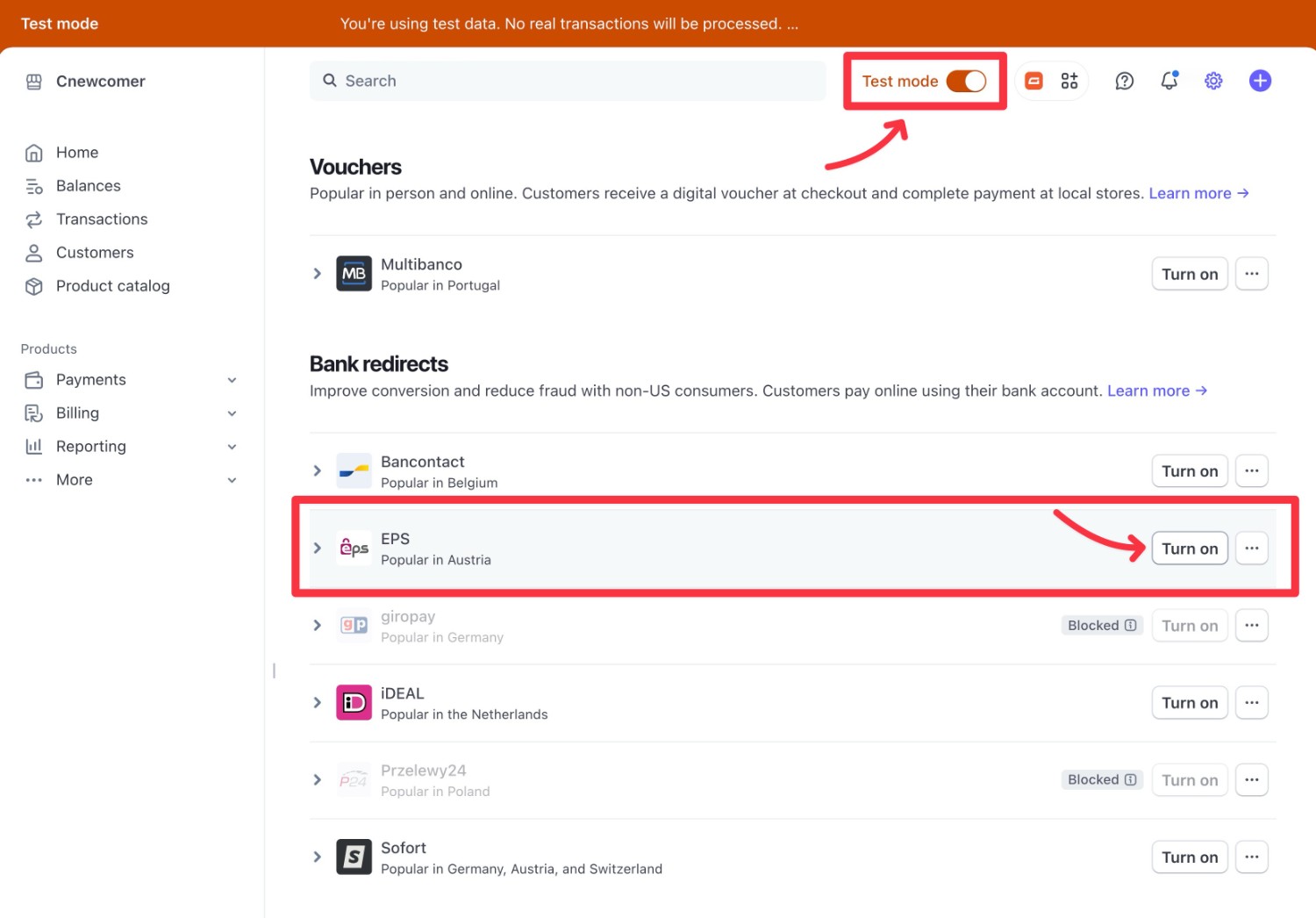
If you want to only offer EPS as a payment method in certain situations, you can then click the three dots icon to create custom rules:
- You can choose to only show EPS as a payment option if the customer is located in Austria.
- You can choose to only show EPS for certain transaction amounts, with options to set a minimum and/or maximum amount.
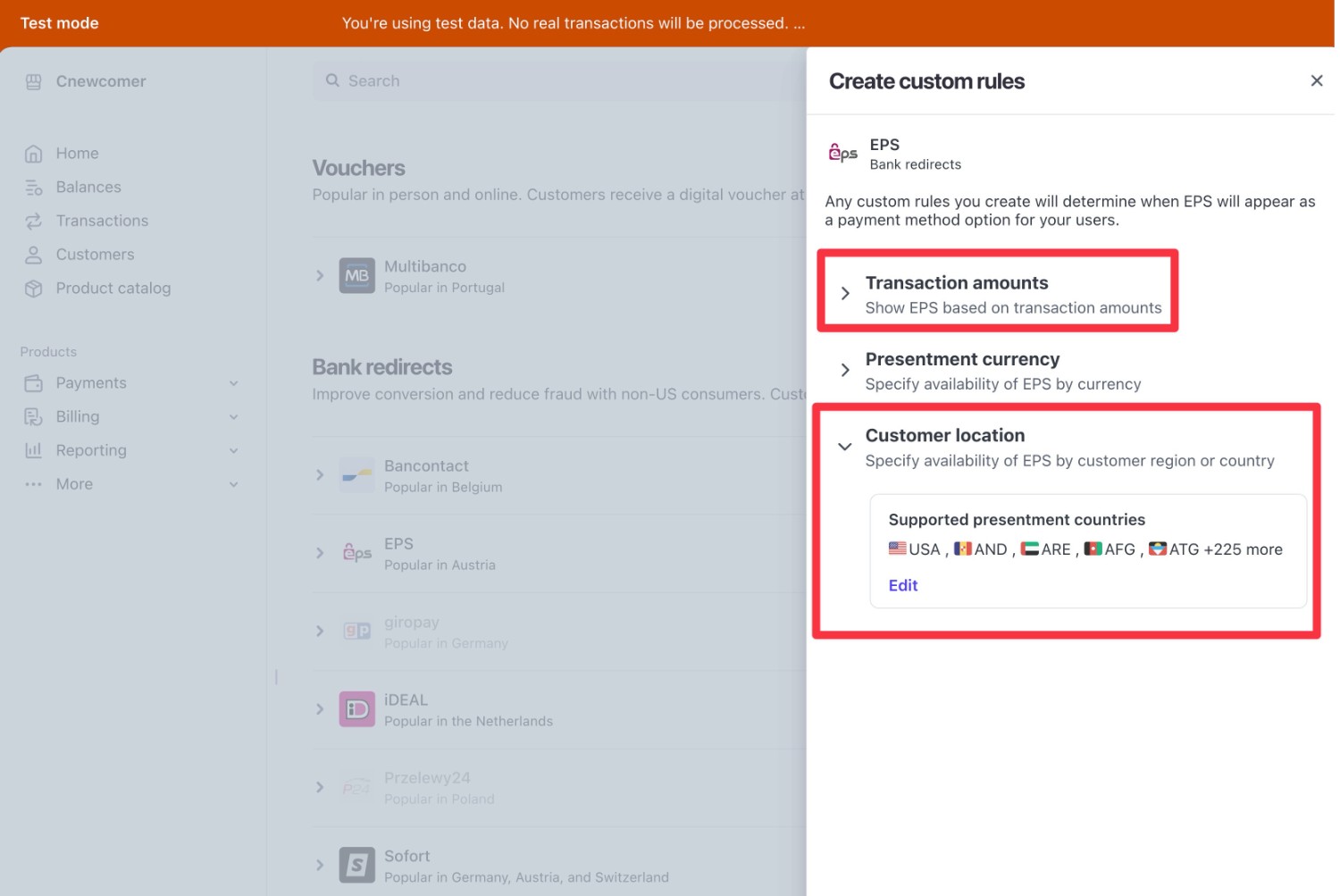
4. Create Your EPS Payment Form
Now, you’re ready to create the actual EPS payment form that your customers will use to make their payments.
To create a new form, go to Forms → New Form in WordPress.
To save time, we recommend using the premade Stripe Checkout Form template. You can still fully customize the template, but it already includes all of the essential fields that you need.
Or, you’re always free to start from a blank slate.
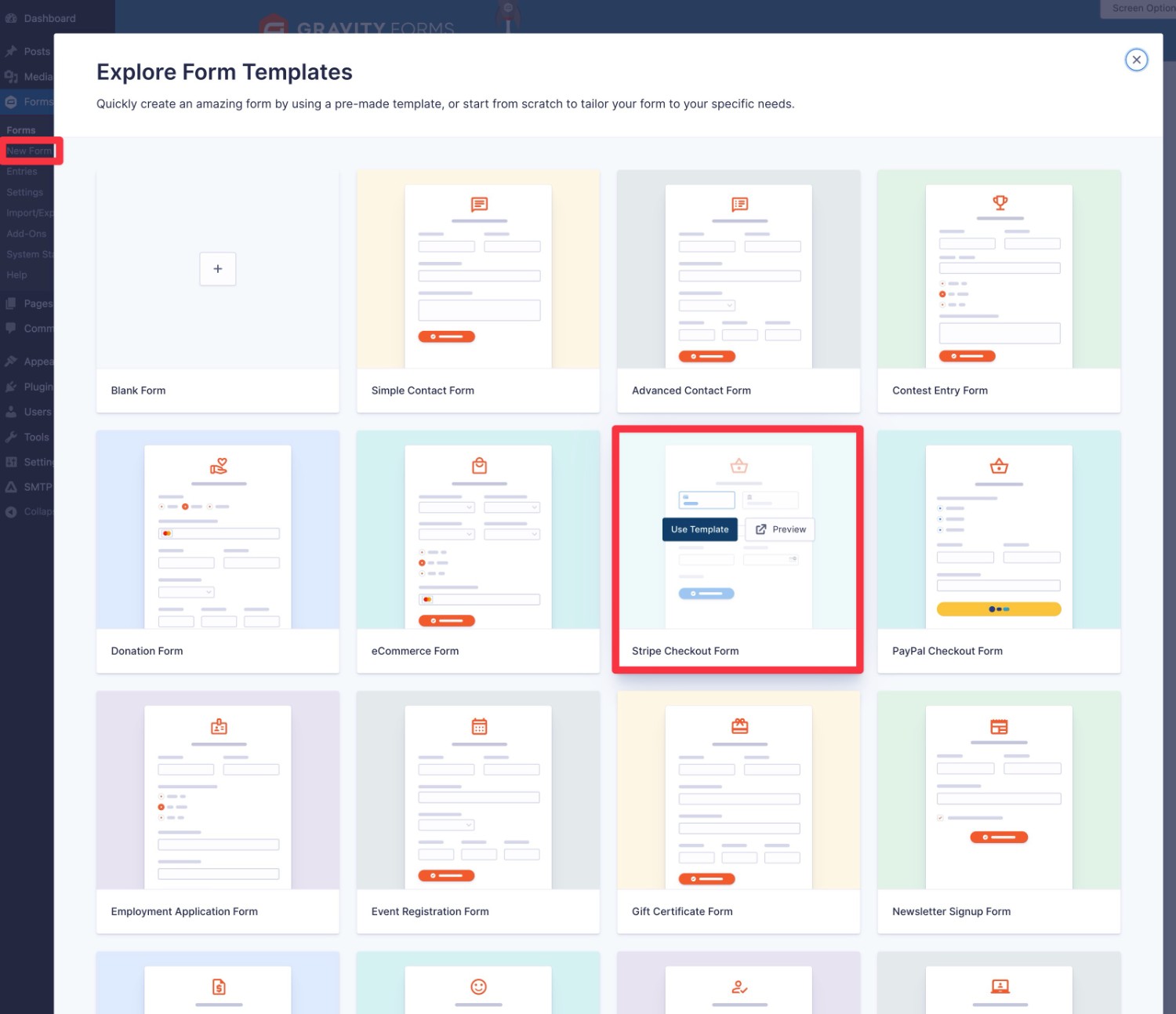
After giving your form a name, you’ll be taken to the drag-and-drop form builder interface.
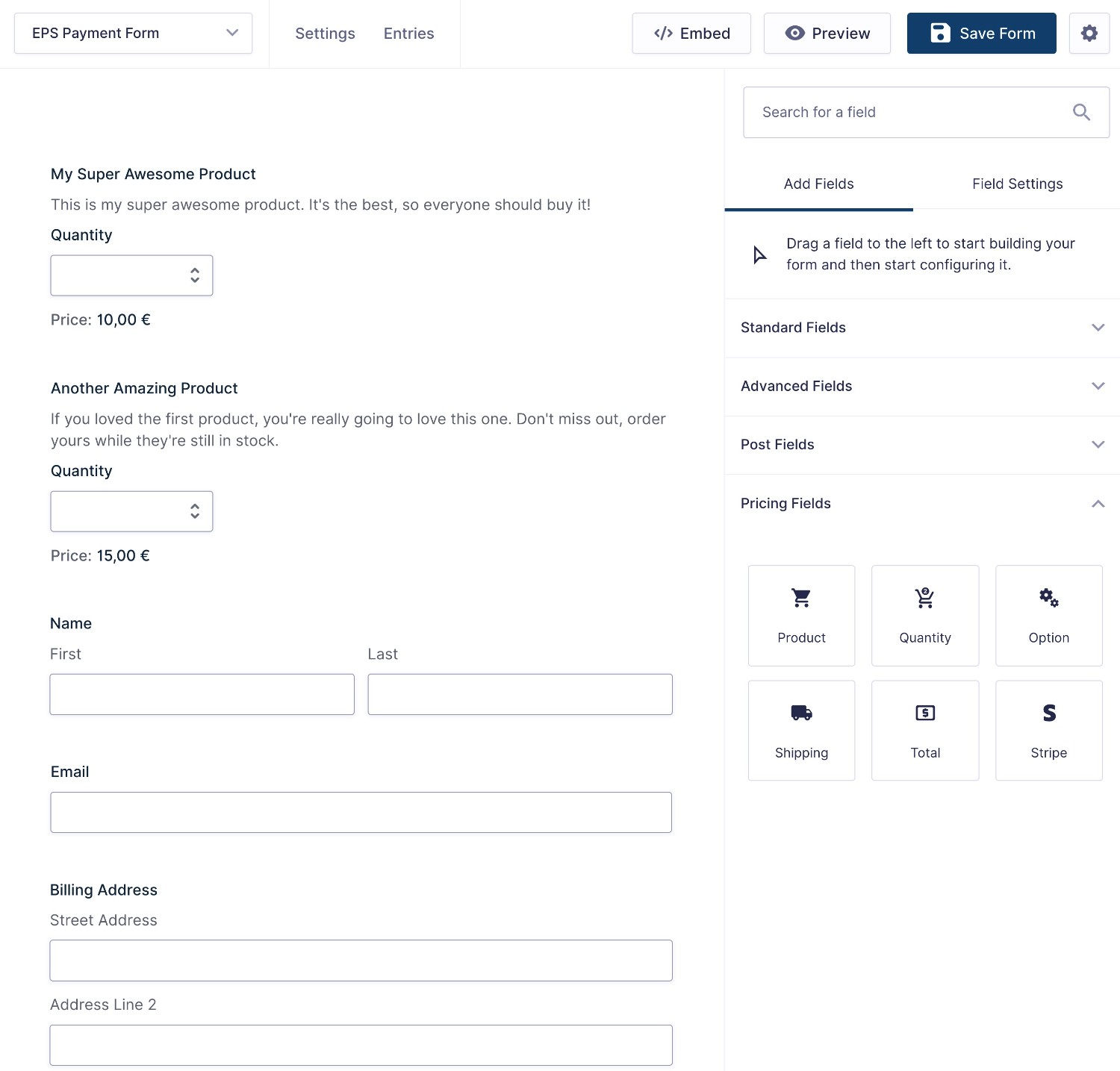
You can customize the form according to your preferences, but you’ll want to include three general types of fields at a minimum:
- General information fields
- Pricing fields
- Stripe field
General Information Fields
You can use general information fields to collect information about your customer such as their name, address, email address, phone number, etc.
You can map this information to Stripe and you’ll also probably want to collect it for your own records.
The template will already include the essential fields, but feel free to add more fields if you need to collect additional information.
Pricing Fields
Pricing fields are what will determine the amount that the customer pays. You could configure your form so that every single customer pays the same amount or you could adjust the payment amount based on the person’s choices when filling out the form.
There are a few different pricing fields that you can use, so we recommend reading the pricing fields documentation if you need help with anything here:
Stripe Field
To accept EPS payments, your form must include a Stripe field. Typically, you’ll add this at the end of your form, as it’s where customers will choose their payment methods and complete their purchases.
By default, the field will only show options for credit/debit card payments.
To display EPS, you need to edit the field’s settings and check the box to Enable Additional Payment Methods.
You won’t see a preview of the field in the editor until you create a Stripe feed, which is the next step.
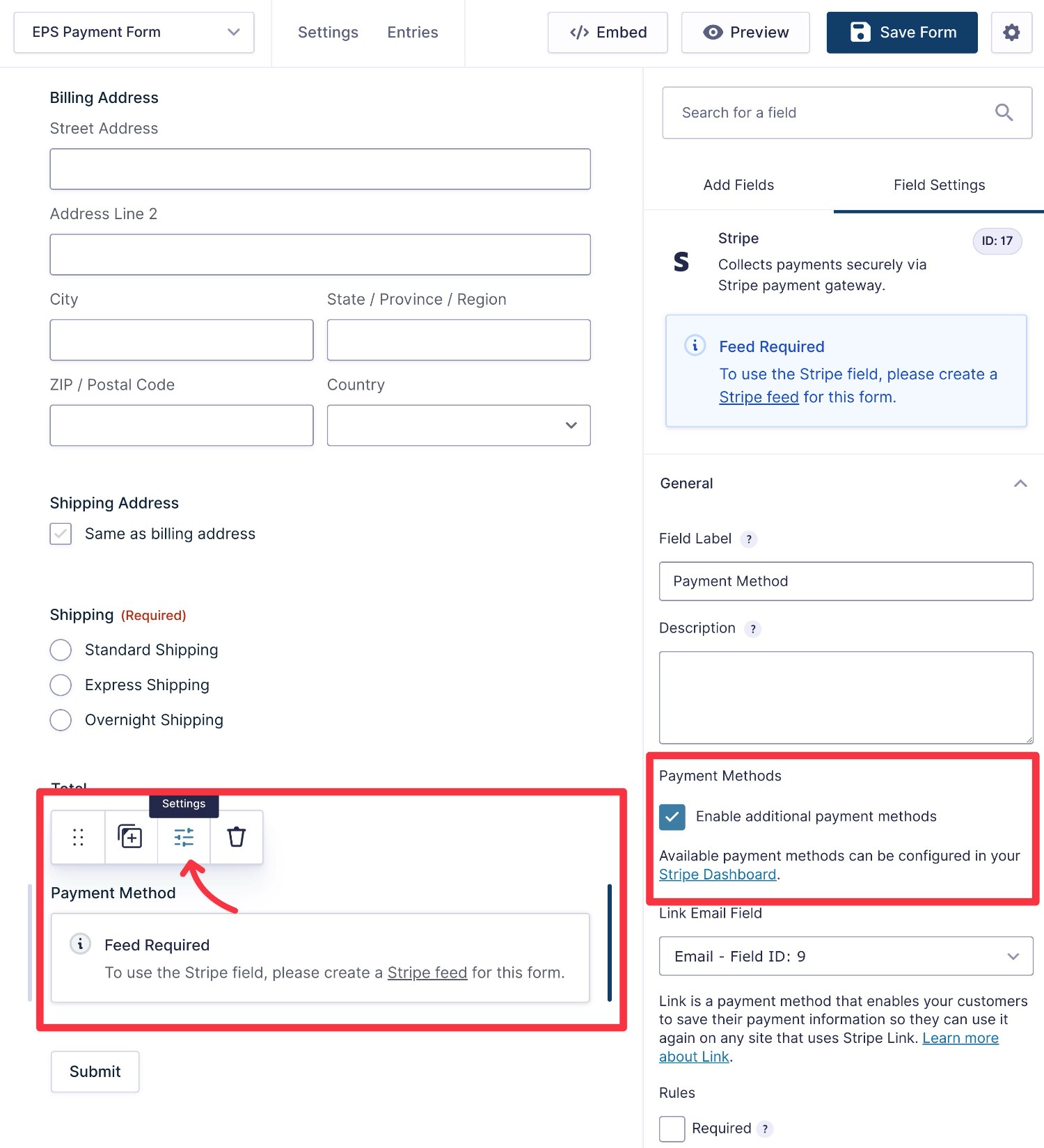
Note – If you only want to offer EPS as the sole payment method, you can turn off all the other payment methods in your Stripe dashboard (including credit cards).
5. Create a Stripe Feed to Control Payment Processing
To control how Stripe should process a customer’s payment and map form information to Stripe, you need to create a “feed” in Gravity Forms.
In the form editor interface, go to Settings → Stripe. Then, click Add New to create your Stripe feed:
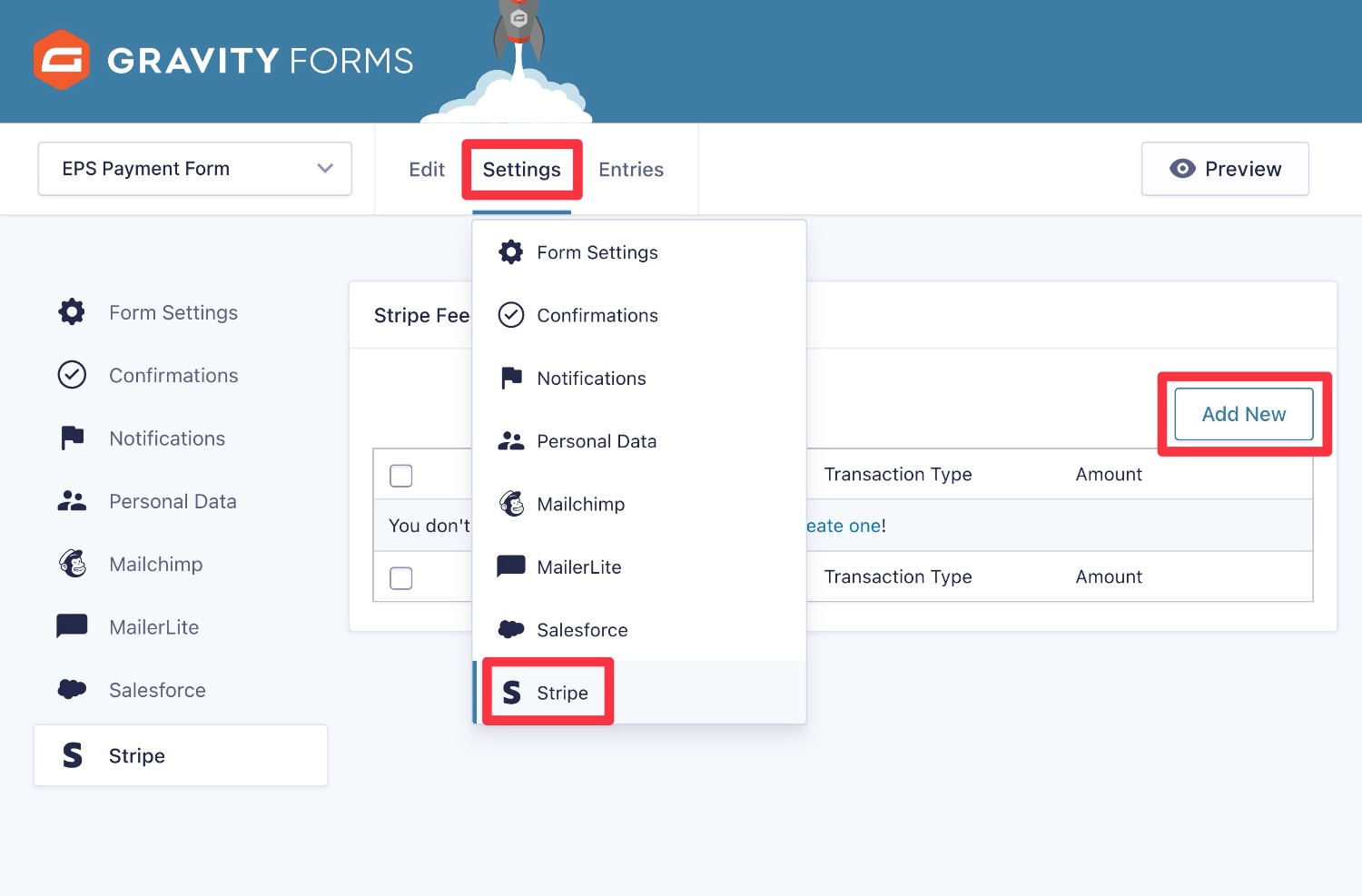
First, you need to choose the Transaction Type:
- Products and Services – Choose this for one-time payments.
- Subscriptions – Choose this for recurring payments.
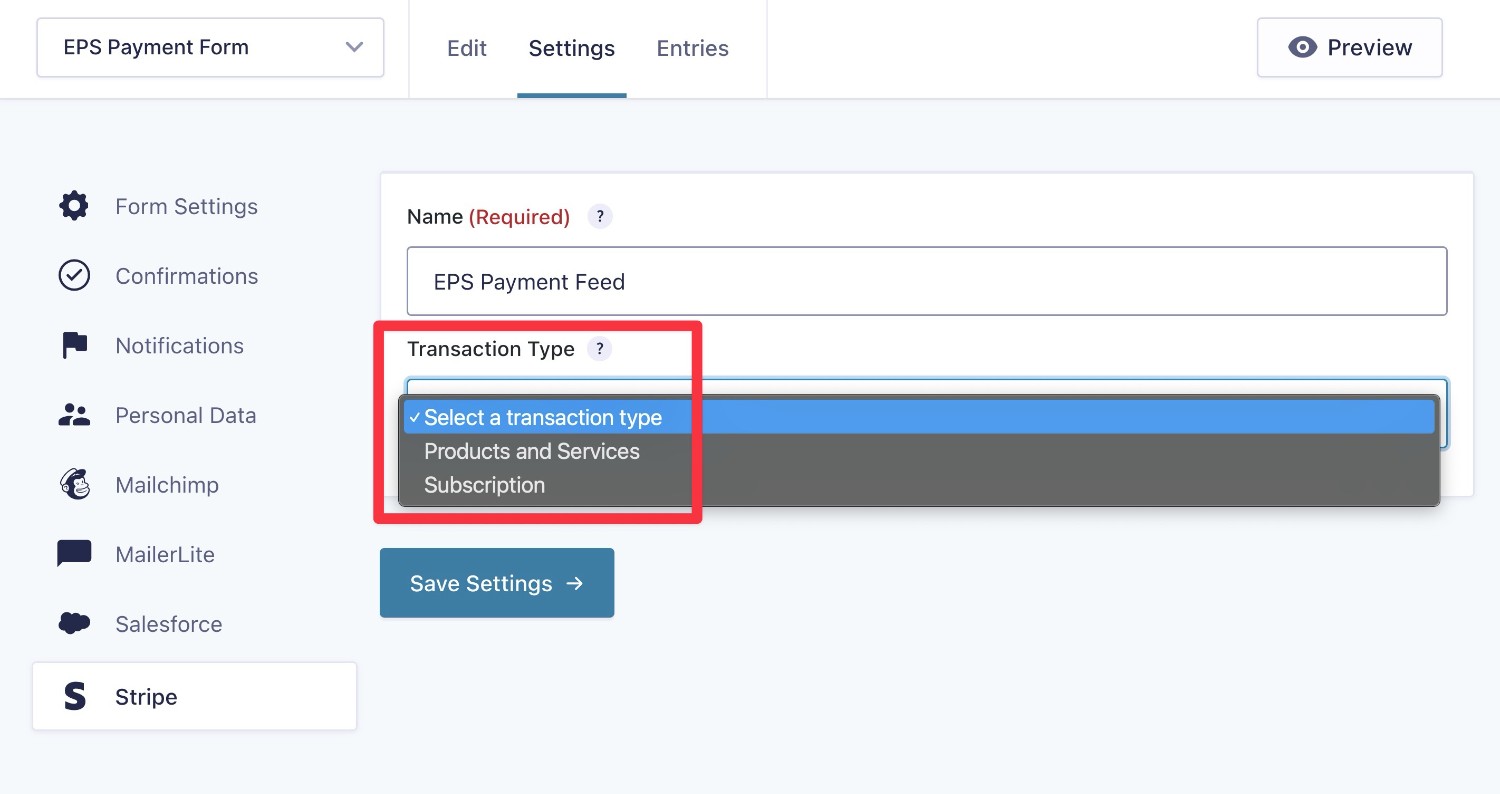
Once you make your choice, you’ll see some additional options.
In these options, you can choose which form field to use for the payment amount (usually the Total field) and also map other form field data to Stripe. You might also get a few other options that are specific to that type of payment.
For more information about all of the feed options, check out the Stripe feed documentation.
Make sure to click Save Settings when you’re done.
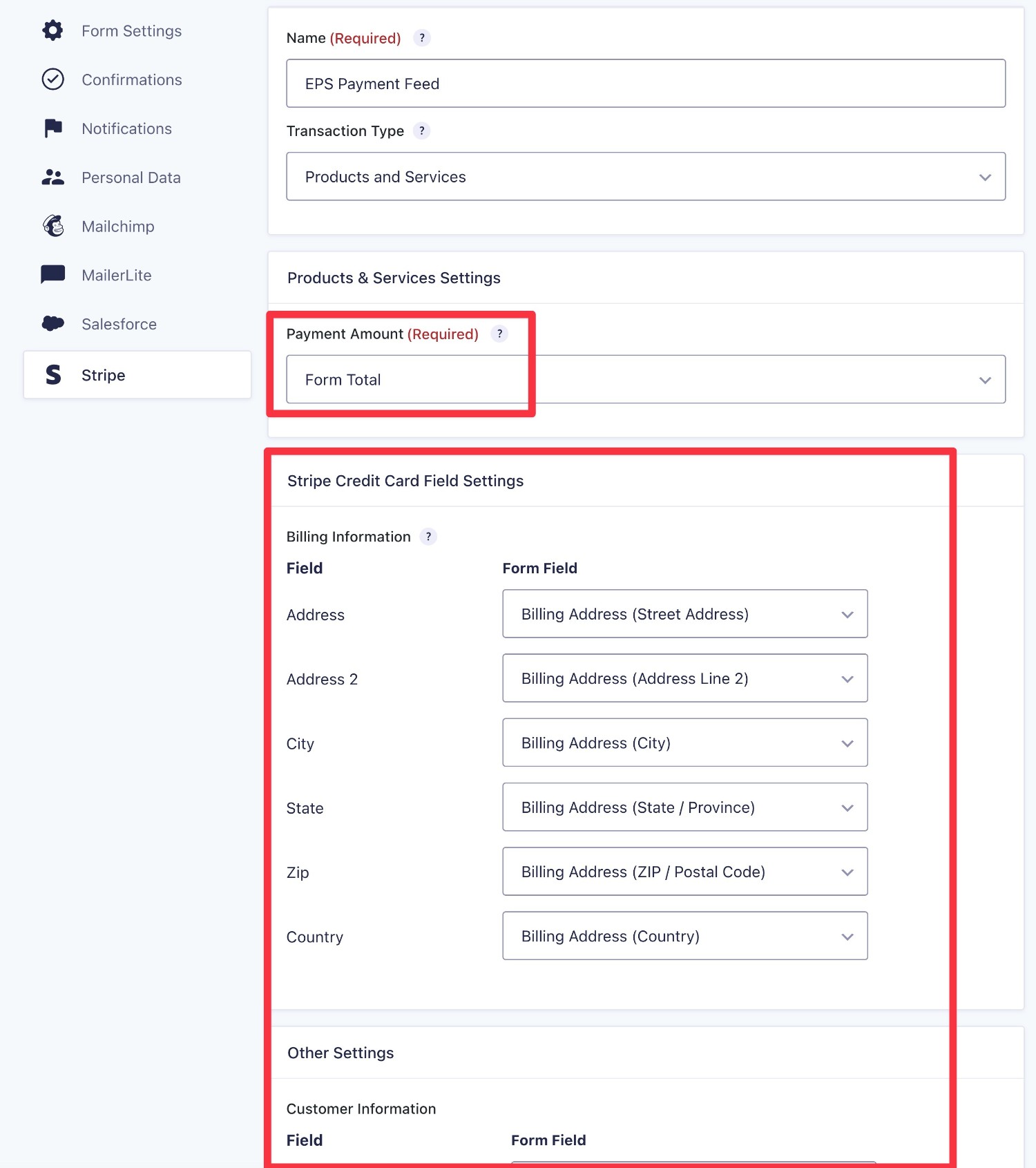
For more complex situations, you can also create multiple Stripe feeds and use conditional logic to control when to execute each feed.
6. Set Up Other Integrations and Features (Optional)
This step is 100% optional.
However, another advantage of using Gravity Forms for WordPress EPS payments is that you can integrate additional Gravity Forms features and integrations into your payment forms.
Here are a few examples of what you might want to do:
- Add a person to your customer relationship manager (CRM) after a successful payment, including applying a certain tag.
- Add a checkbox that lets people subscribe to your email newsletter as part of making their payment.
- Trigger an automation in other software using Zapier or webhooks, which lets you integrate your EPS payment form into pretty much any tool that you’re using.
You can browse all of the Gravity Forms add-ons to get some more ideas.
Typically, you’ll need to install the add-on for the relevant integration, connect your site to that service, and then create a feed in your payment form settings.
7. Embed Your Form and Make Some Test Payments
You’re now pretty much finished in terms of configuring your EPS payment form.
Now, you can embed the form on your site and then submit some test payments to make sure that it’s working as you want it to.
You can embed the form anywhere on your site using the Gravity Forms block, shortcode, or PHP function. If you use the block, you can also use the Orbital form theme to style your payment form directly from the block editor.
After embedding the form, you can open the post or page where you added the form and submit some test payments.
When you fill out the form, you should see EPS appear as the payment method (or one of the payment options if you’ve enabled multiple methods).
If you select EPS, you’ll see an additional option to choose your bank.
If you don’t, we’ll cover some troubleshooting steps below.

To test it, you can submit the form. This will take you to a dummy interface where you can authorize the EPS payment.
For a real payment, the customer would be prompted to authenticate the payment with their bank credentials.
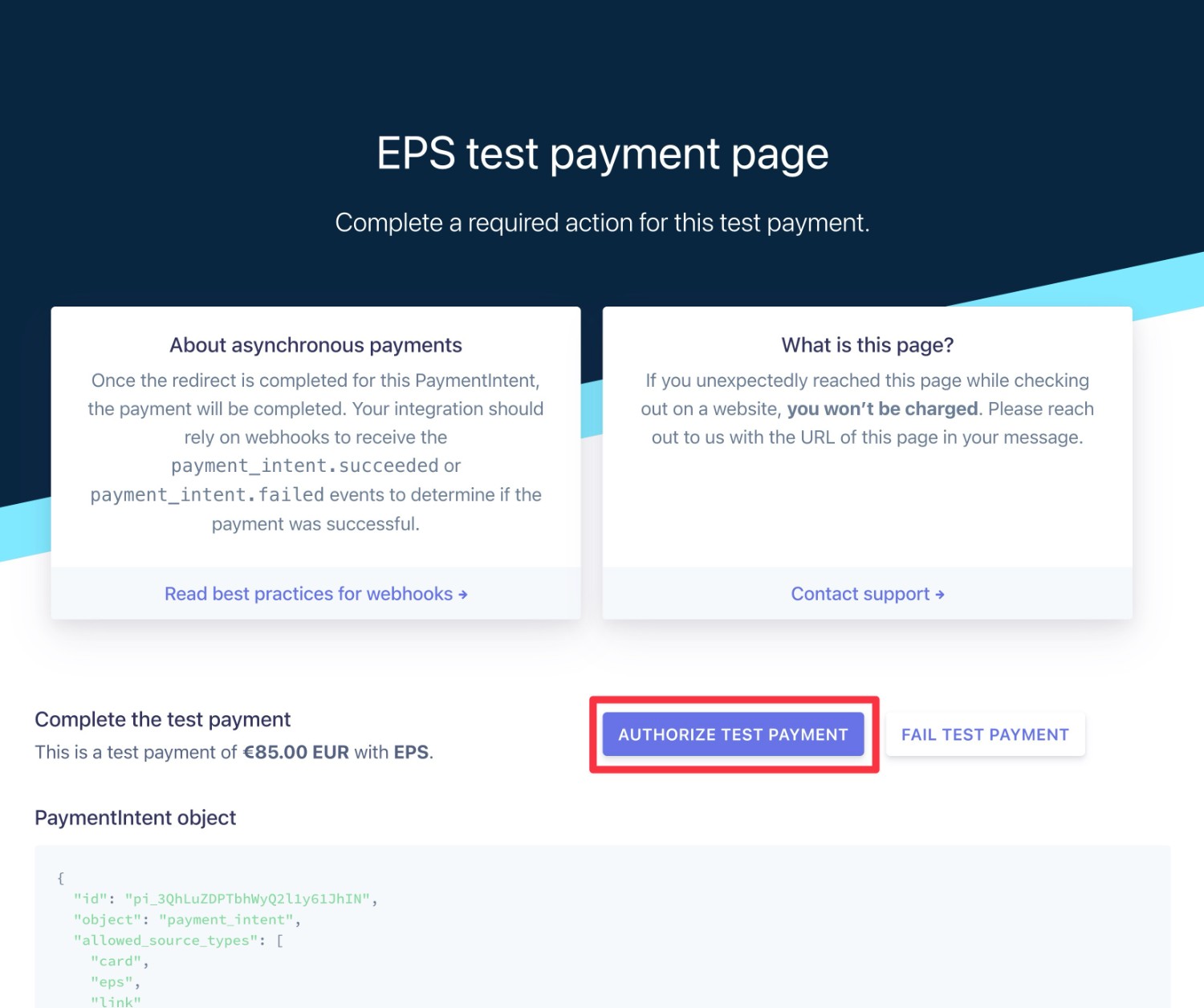
After making this test payment, you should see the payment appear in both your WordPress dashboard (Forms → Entries) and your Stripe test dashboard.
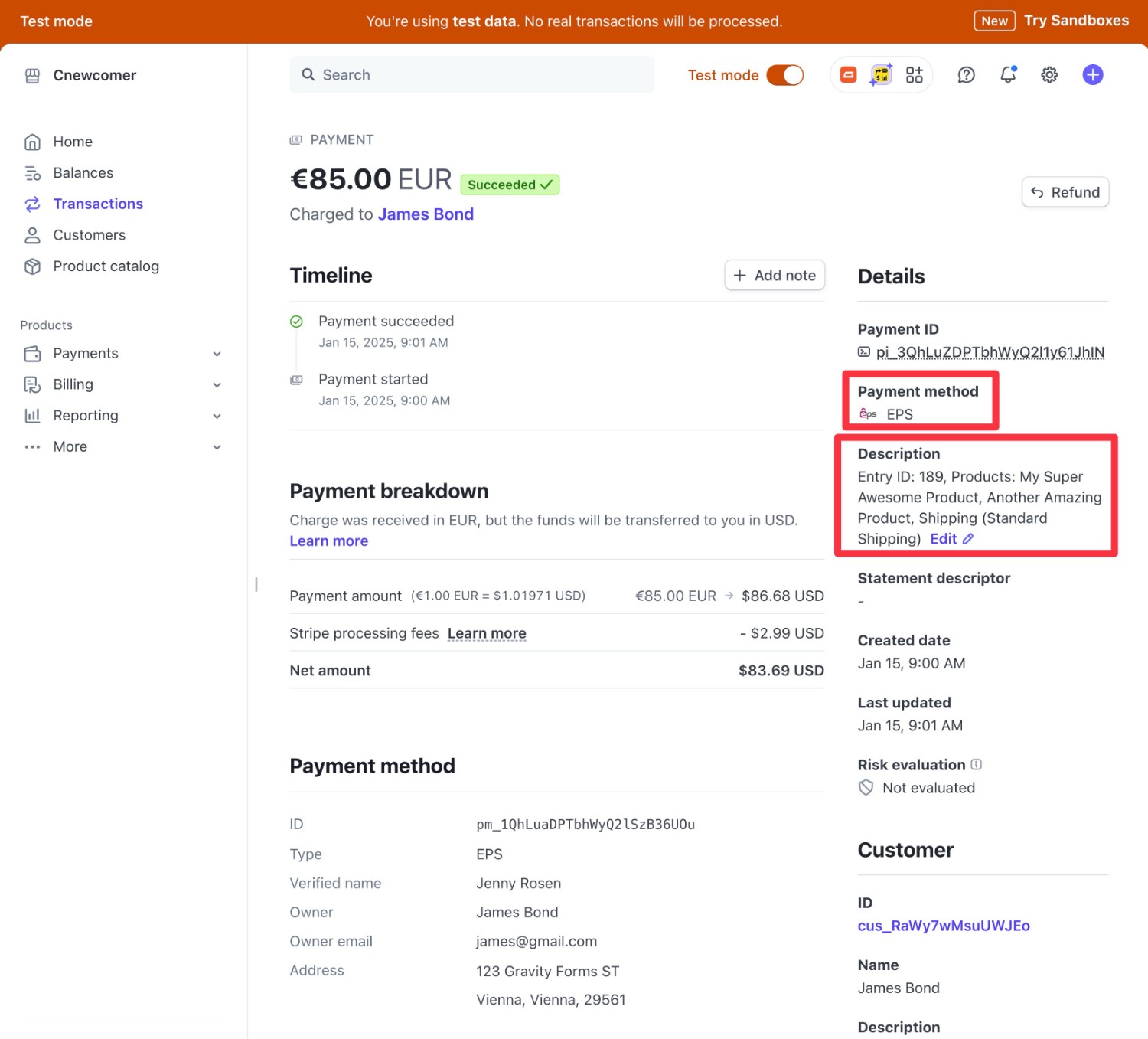
If you do not see EPS as a payment option, here are some things to check:
- Make sure you set the Gravity Forms Default Currency to Euro. You won’t see EPS if you configured Gravity Forms to use a different currency. You can change this by going to Forms → Settings.
- Make sure you specifically enabled EPS for “Gravity Forms by Rocketgenius” in your Stripe dashboard.
- Make sure you checked the Enable Additional Payment Methods box in the Stripe form field settings.
8. Enable Live Mode to Accept Real EPS Payments
If everything worked well with the test payment, you’re now ready to start accepting real payments via EPS.
To enable live payment processing, you will basically repeat the same actions from Step #2 in this tutorial. However, you’ll do them for Live mode instead of Test mode.
- Go to Forms → Settings → Stripe in your WordPress dashboard.
- Change the radio button from Test to Live.
- Click Connect with Stripe to authenticate Gravity Forms with your live Stripe account.
- Add the Gravity Forms webhook URL to the live version of your Stripe dashboard. You can follow the same instructions using Stripe Workbench – you’ll just be working in the live version of your Stripe dashboard instead of in test mode.
- Copy the live signing secret key from the Stripe dashboard and paste it into the Live Signing Secret box in the Gravity Forms settings.
- Save everything.
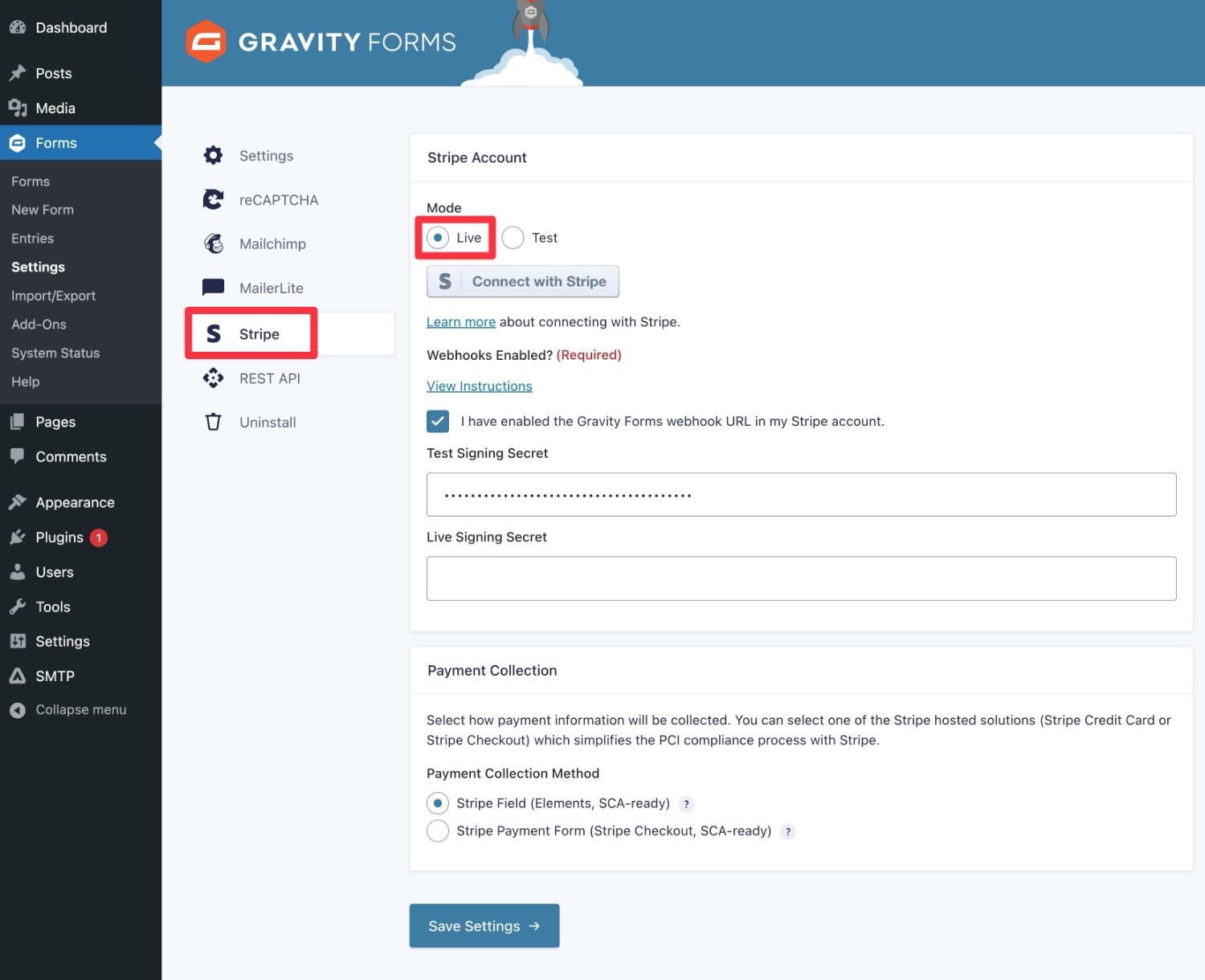
Your site will now start processing real customer payments whenever people use your EPS payment form.
For more information on how to get started with Gravity Forms and Stripe, check out our documentation.
Get Started With EPS Payments Today
If you have customers in Austria, you should consider offering EPS as a payment option because of its convenience, widespread acceptance, and lower risk of fraudulent payments.
With Gravity Forms and Stripe, you can easily create your own custom WordPress EPS payment forms and add them anywhere on your site.
If you’re ready to get started with your first payment form, purchase the Gravity Forms Pro, Elite, or Nonprofit license today!

If you want to keep up-to-date with what’s happening on the blog sign up for the Gravity Forms newsletter!
